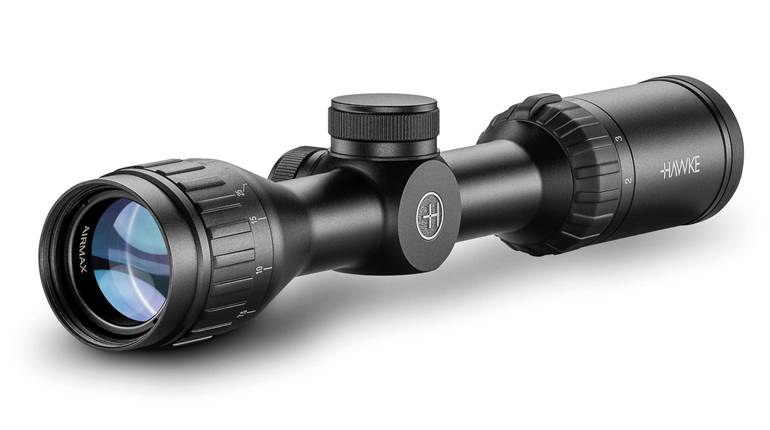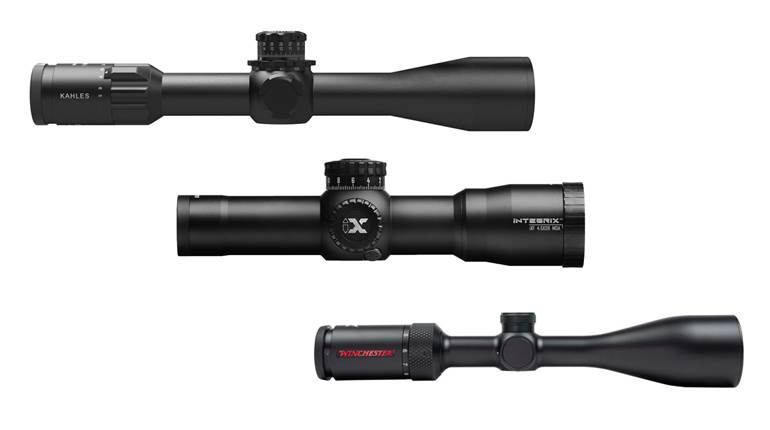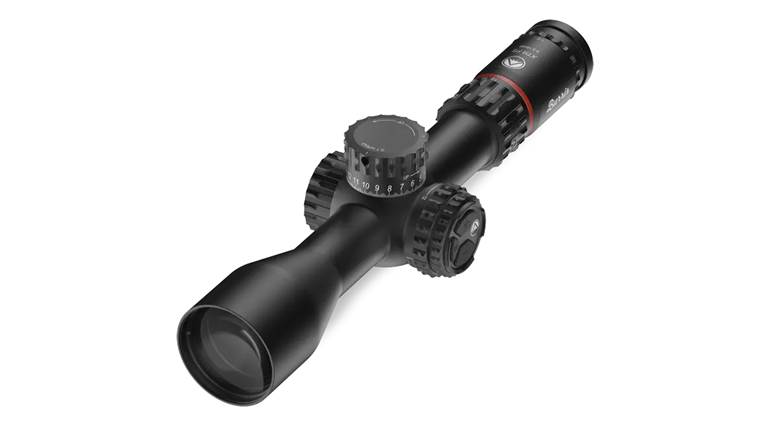
One of the hottest trends in firearms is long-range rifle shooting. Due to its popularity, innovative products have entered the market, providing shooters with the tools they need to make hits at previously unheard-of distances. Among the most important items in this equation is the scope, and more and more riflescopes are being built with long-range shooting in mind. But as these products have added features, their sizes have increased drastically; the most popular scope models used by competitors in the Precision Rifle Series are about 16" long and tip the scales at nearly 40 ozs. The EOTech Vudu 5-25X 50 mm optic reviewed here, however, bucks that trend, packing a great number of features into a relatively small package.
Like all of the scopes in the Vudu series, the 5-25X 50 mm is made in Japan using a one-piece aluminum body and AR-coated high-definition glass. The 5-25X 50 mm is one of the shortest scopes in the Vudu lineup at 11.2"; by comparison, the company’s otherwise compact 2.5-10X scope is actually longer by almost 3". The reason the scope was made to be so short is twofold—first, the compact dimensions mean a more portable package in the real world and, second, a short riflescope allows more room for the mounting of night-vision or thermal optics in front of it, something that has become increasingly common in law enforcement and military circles. The 5-25X 50 mm Vudu weighs 29.5 ozs., which is on the lighter end of scopes in this category.

A 34 mm main tube makes room for a generous adjustment range of 14.5 mils of elevation and 11.5 mils of windage. With the reticle zeroed in the center of the adjustment range, the Vudu is capable of dialing to beyond 1,300 yds. with a sample 6.5 mm Creedmoor load, and a scope base with built-in elevation would extend this maximum dial range even farther. This optic is available with one of two first-focal-plane (FFP) reticles, the MD3 and the Horus H59. Both provide mil-based windage and elevation holds, and, because the reticle is situated on the FFP, these graduations are true at any magnification setting. We tested the MD3 reticle, which was useful and intuitive but not overly busy. This reticle provides holds at 0.2-mil increments for up to 5.8 mils of windage and 12 mils of elevation. Due to the 50 mm objective, this scope can be mounted closer to the bore than most of its 56 mm competitors.
The windage turret is capped, so that it cannot be twisted inadvertently; the elevation turret is exposed, but it is lockable. Both use positive, audible and tactile adjustments in 0.1-mil increments. An easy-to-use zero-stop allows the user to set the turret so that it cannot be dialed below the rifle’s zero. Parallax is adjustable via a turret at the scope’s 9-o’clock position, and dials from 45 meters to infinity. Buttons situated outboard of the parallax dial are the illumination controls, which include an on/off button and up and down adjustments to change the brightness of the scope’s red LED reticle. The power adjustment rotates the entire ocular lens housing, making for quick, easy magnification changes. A removable throw lever is provided to allow for additional leverage and quicker adjustments.

Optical clarity is a factor whose importance has been inflated by marketing, but, nonetheless, one cannot hit what cannot be seen. Thanks to the high-quality glass and fully multicoated lenses, the Vudu possesses excellent clarity. We mounted the Vudu to a rifle of known accuracy, a heavy bolt-action chambered in 6.5 mm Creedmoor that had established itself as a sub-half-m.o.a. rifle with Hornady’s 140-gr. Match load. After boresighting, we then fired a few three-shot groups and achieved the same accuracy that the rifle had exhibited using a scope of known performance. Everything looked great at first glance, so it was time for some more difficult tests.
For shooting at extended ranges, it is imperative that a scope’s adjustments track with consistent precision and that they do not wander on the vertical or horizontal plane when changes are made. Not all shooters use dials, so it is also important that a reticle’s hold-over and hold-off marks are subtended properly so that they can be effectively used for elevation and windage holds. In order to test each of these factors, we constructed a special target designed to evaluate the various performance aspects of this optic. The first thing we evaluated was the accuracy of the reticle graduations. One mil translates to 3.6" at 100 yds., so we created a target that resembled a vertical ruler, with horizontal hash marks every 3.6" for 36 total inches. With this target mounted downrange at 100 yds., we were able to match the mil lines in the reticle with the mil lines on the target—at every power level the reticle proved to be accurate.
A second test used the same vertical target, which we confirmed to be perfectly level. We aligned the vertical section of the scope’s reticle with the vertical line on the target to ensure that the rifle was not significantly canted. We then fired a round at the bottom of the target, which struck the point of aim perfectly. Next, we dialed the scope for five mils of elevation and fired another round. The round struck the five mil mark on the target, indicating that the scope was tracking both accurately and in the proper direction. Finally, we dialed five more mils of elevation into the scope (10 total) and fired another round. Like the other two, the third shot hit exactly where it should have. We repeated the process back down to the five-mil line and again to the zero point, with each additional round landing in the appropriate position on the target.
We had proven that the reticle could track vertically with precision, but windage adjustments can be equally important. In order to test both the windage and elevation adjustments, we “shot the square.” Our target consisted of a square that measured 3.6" per side. Starting at the lower-left corner, a round was fired before the Vudu was dialed up
10 clicks for a second shot. The windage adjustment was then run 10 clicks to the right for a third shot and then back down one mil for shot number four. We shot around the square four times total, with the result being neat half-inch clusters at each corner.
The 5-25X 50 mm Vudu’s optical performance, mechanical accuracy and overall structural integrity were all found to be excellent. In a crowded market of long-range optics, EOTech’s 5-25X 50 mm Vudu stands out as a high-performance riflescope in a compact and relatively lightweight package. The precision of its adjustments and accurate tracking capability are must-haves for this application, and the optical clarity is an attractive bonus. This optic may be short in stature, but it’s capable of big things.







































